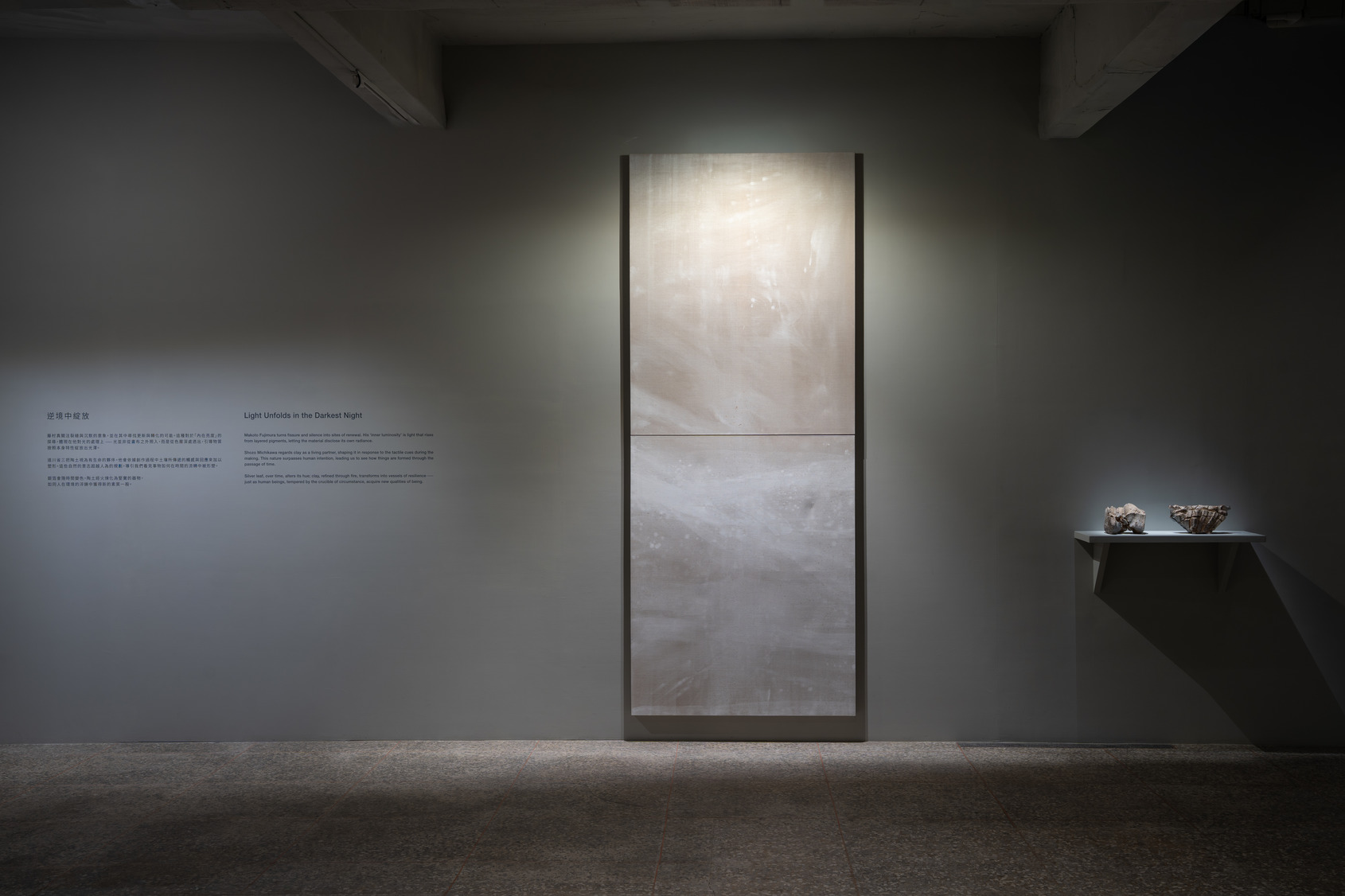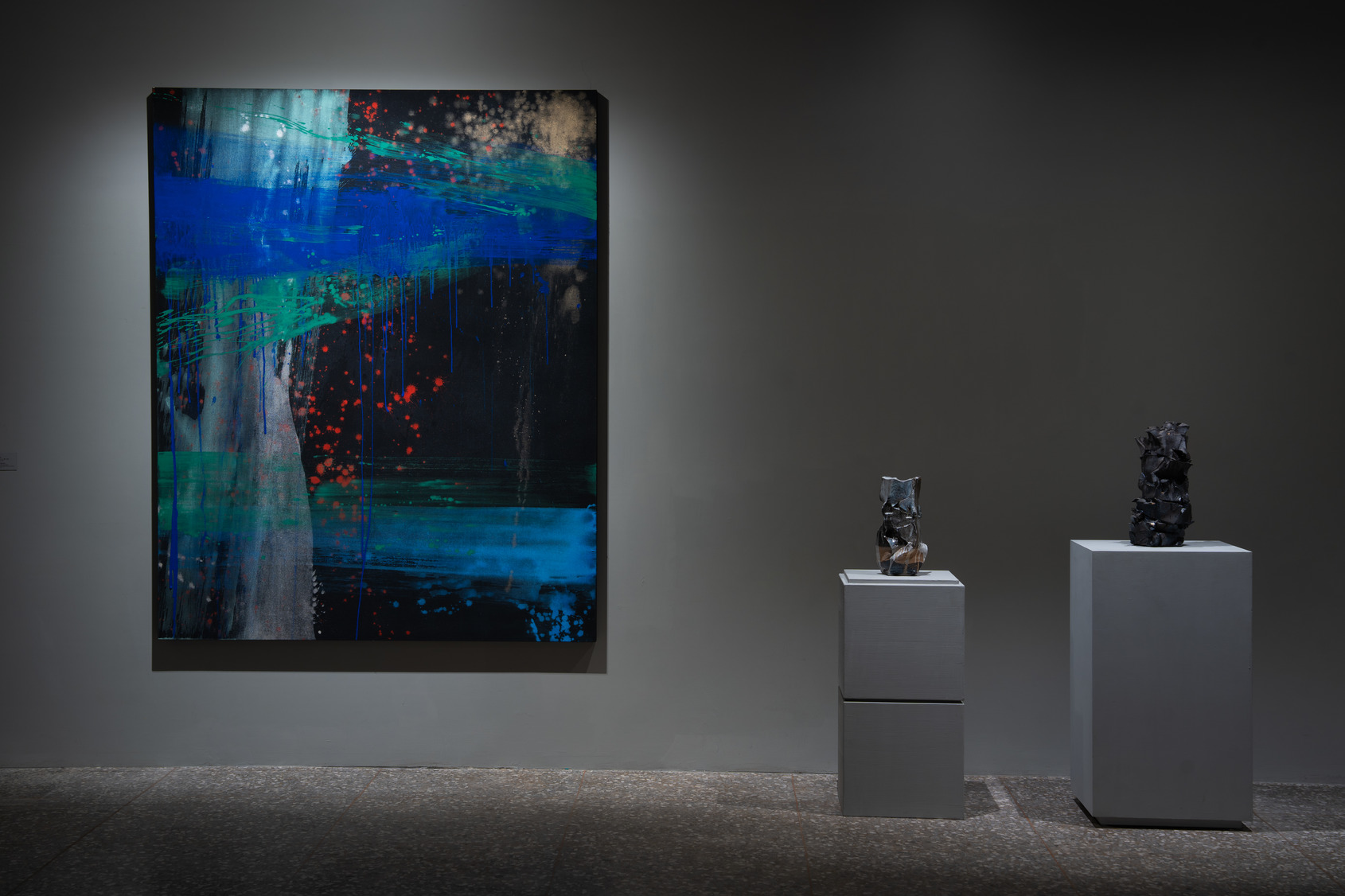Makoto Fujimura (b. 1960) is a contemporary abstract expressionist painter, renowned for the spiritual depth and intellectual rigor of his art. His works combine intrinsic qualities of both Eastern and Western art, addressing themes of restoration and renewal in a turbulent world, celebrating the stillness and blossoming of life. Through the meditative use of mineral pigments, he reveals a refined beauty that is both delicate and profound.
His works have been exhibited widely across North America, Europe, and Asia, earning him deep respect within cultural and artistic circles. From 2003 to 2009, he was appointed by the President of the United States to serve on the National Council on the Arts, where he advised on arts policy and participated in the nomination and selection of National Medal of Arts recipients.
Makoto Fujimura insists that art must provide spiritual guidance and humanitarian concern. He has authored several books articulating these ideas, including Art + Faith, Culture Care, and Silence and Beauty. He has also embodied these convictions through action — participating in memorials for the Columbine High School tragedy, contributing to the reconstruction efforts after the 2011 Tōhoku earthquake and tsunami, and engaging in relief work in the slums of India. For him, art’s mission extends beyond the canvas into cultural and human care.
This major retrospective Dust and Gold is presented by ALIEN Art Centre and jointly organized by ALIEN Art and Artrue International. It brings together Makoto Fujimura’s most iconic series, bearing witness to how his artistic practice reveals glimpses of eternity amid the noise of the contemporary world. It demonstrates how his vision elevates abstract expressionism into a mode capable of touching the human soul, leading viewers toward an experience of “a new heaven and a new earth.”
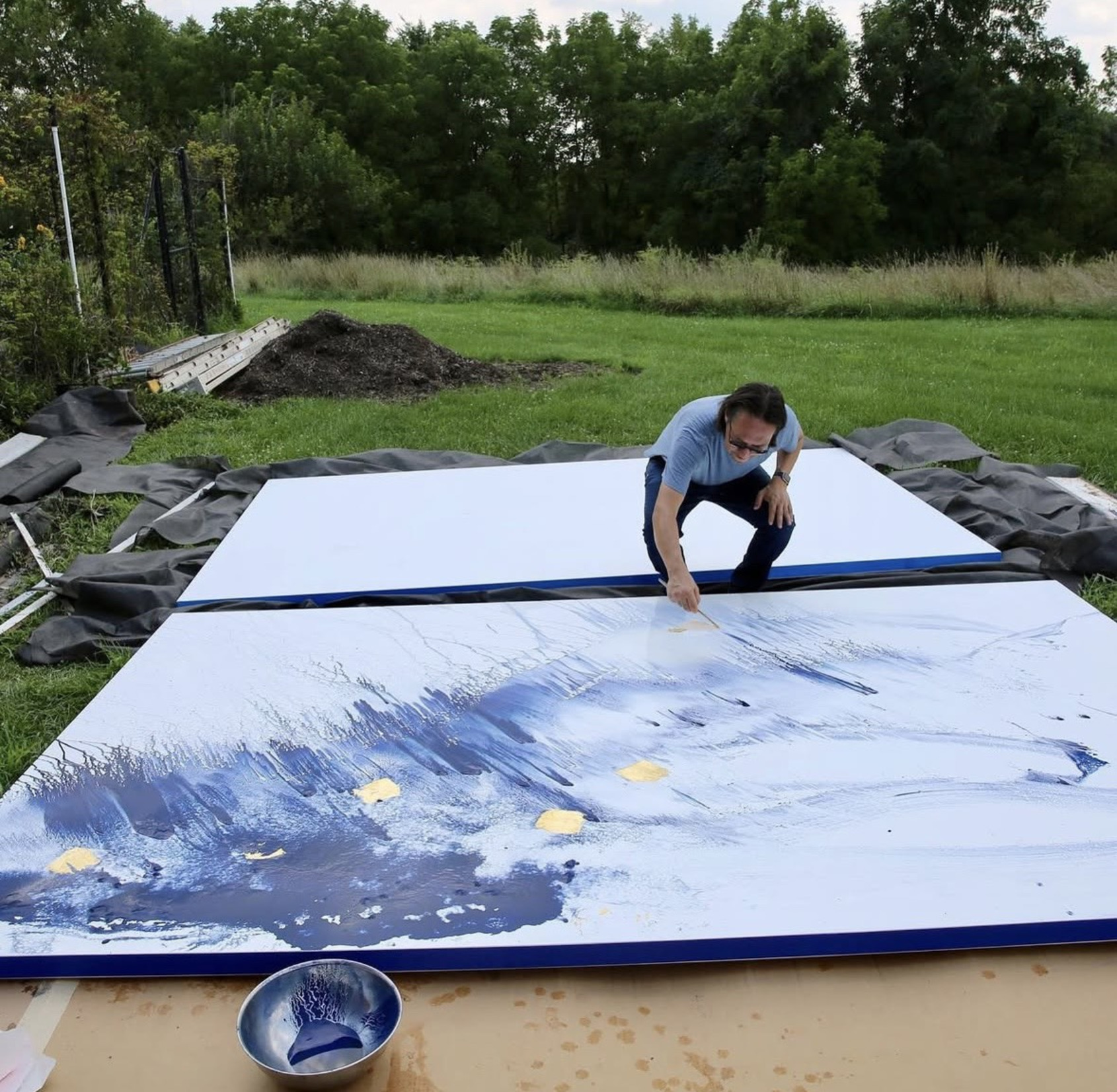 Artist in the act of creation © courtesy of the artist Early Life
Artist in the act of creation © courtesy of the artist Early LifeMakoto Fujimura’s father was an acoustics and linguistics expert, and his mother an educator. Born in Boston, he showed a love for painting from childhood and was encouraged by his parents. He spent his early years in Sweden, attended school in Japan, and returned to the United States at the age of thirteen.
He began his undergraduate studies at Bucknell University, where he committed to painting as his vocation. After graduation, he pursued traditional Japanese painting (Nihonga) at Tokyo University of the Arts, earning a Master of Fine Arts. He later received a scholarship from the Japanese government, continuing advanced studies alongside fellow painters such as Takashi Murakami and Hiroshi Senju.
During his years in Japan, Makoto Fujimura’s creative energy flowed like an inexhaustible spring. He treasured this transcendent force, dedicating himself to exploring the mysteries of creation, and embraced the belief that art must carry spiritual power to engage with the world and translate faith into action.
Artistic StyleMakoto Fujimura works with traditional
Nihonga materials — natural mineral pigments and high-strength handmade Japanese paper (
washi). Through the careful layering of 80 to 100 applications of color, with deliberate control of moisture and time, he produces surfaces imbued with resonance and natural vitality. He often incorporates gold leaf, silver, and platinum, creating crystalline refractions and luminous effects akin to pointillist reliefs.
Yet his art is also unmistakably influenced by Western abstract expressionism. From Kandinsky’s early abstractions in the 1910s, abstract expressionism developed into one of the most significant art movements of the 20th century. By the 1950s, the movement had branched into two dominant tendencies: the gestural and improvisational mode — rebellious, emotionally charged, and anarchic — exemplified by Willem de Kooning and Jackson Pollock; and the large-scale
color field painting mode, emphasizing psychological depth and meditative space, pioneered by Mark Rothko and Agnes Martin.
Makoto Fujimura’s work bears affinity with the latter. But unlike Rothko’s canvases, often associated with solitude and tragedy, Makoto Fujimura’s aim is to repair trauma, to rediscover beauty in creation, and to transmit light and hope. Compared with Martin’s meditative minimalism seeking spiritual harmony, Makoto Fujimura’s layered process yields luminous surfaces that resonate with both restraint and impact, suggesting a healing power that expands from the self to embrace the cosmos. His method embodies a dual cultural inheritance.
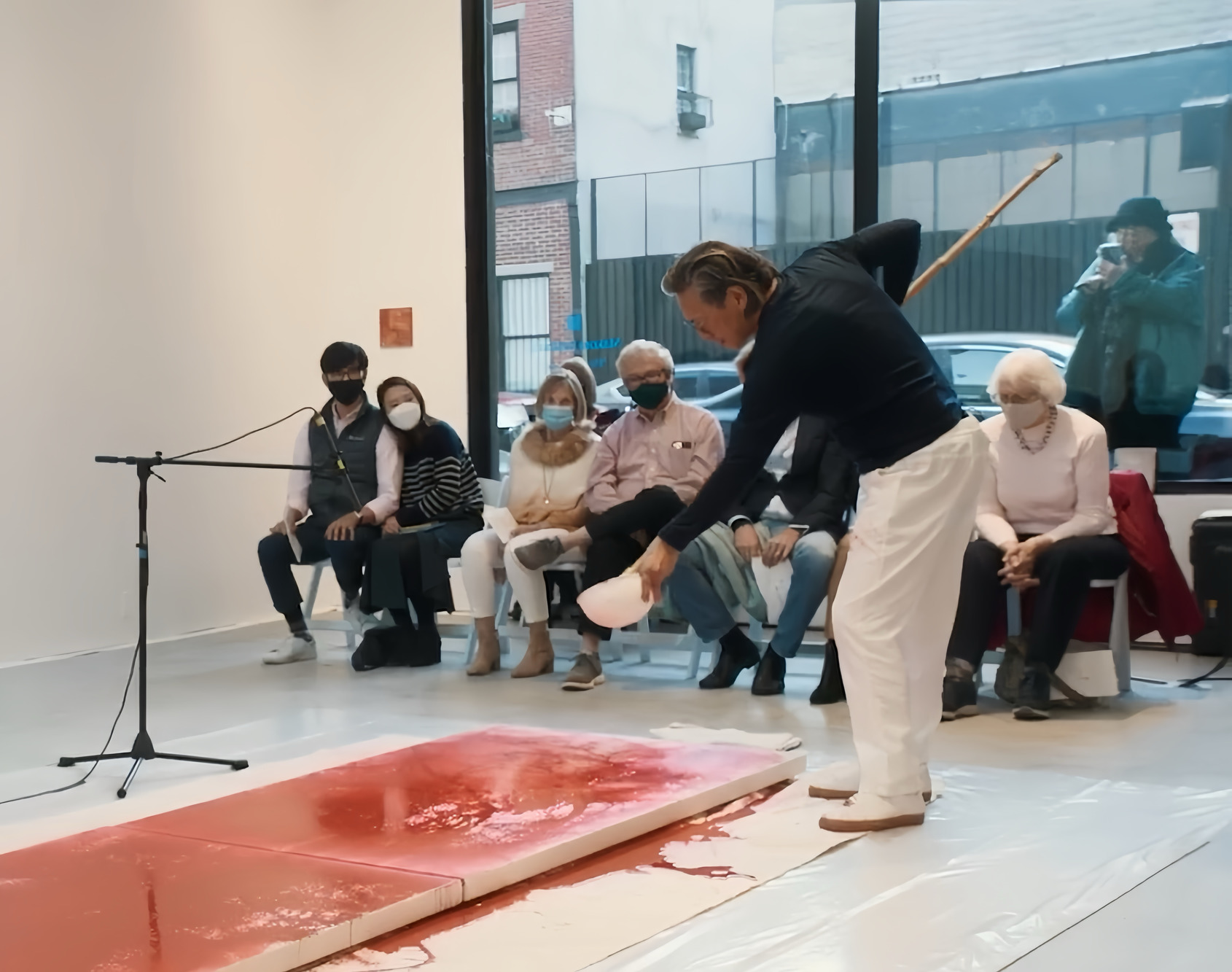 Artist in the act of creation © courtesy of the artist Creative Practice and Characteristics
Artist in the act of creation © courtesy of the artist Creative Practice and CharacteristicsIn earlier centuries, cross-cultural exchange between East and West defined modern art movements. Parisian artists absorbed the aesthetics of
ukiyo-e, with its flat planes, curvilinear lines, decorative motifs, and bold colors, inspiring Impressionism, Post-Impressionism, Art Nouveau, and Fauvism. Western painters integrated Japanese idioms into oil painting and new avant-garde languages, challenging classical traditions and giving rise to modern movements.
Makoto Fujimura goes further. He not only adopts
Nihonga as a medium but also integrates its 500-year-old spiritual ethos into his practice.
First, his painstaking process — applying 80 to 100 layers of pigment — embodies a form of slow art. This practice resists the pressures of efficiency and instrumental rationality, cultivating silence, patience, and contemplation in material form. The result is not merely a painting, but a ritual of stillness — a continual transfiguration of thought into visible form.
Second, he employs precious minerals — malachite, mica, gold and silver leaf — not for ostentation but as offerings. These materials capture light and register time: metals subtly oxidize, pigments shift with air and humidity, transforming each work into a vessel of temporality. Larger pigment grains create luminous refractions, compelling repeated gazes and deep reflection.
He also embraces the Japanese philosophy of
kintsugi — repairing broken pottery with gold lacquer, making cracks part of beauty rather than flaws to be hidden. For Makoto Fujimura,
kintsugi is more than a craft; it is an act of faith, symbolizing grace revealed in brokenness, and the continuity of history and culture. “Kintsugi is not merely about mending vessels,” he notes, “its concept can extend to mending our souls, our communities, and our cultures.”
In sum, through “slow art” and the layering of mineral pigments, Makoto Fujimura creates visual forms that resemble
kintsugi, evoking light from fractures. His works embody both trauma and healing, insisting that art must confront imperfection, enact repair, and transmit beauty and love.
Artistic PositionMakoto Fujimura integrates Western traditions of humanism, history, theology, and creativity with the spirituality of Eastern materials. In doing so, his art responds to a restless world with a call toward healing and hope, offering radiance as a gift of beauty.
His vision echoes Wassily Kandinsky, who a century earlier declared that art must not be confined to art for art’s sake, nor reduced to decoration, commerce, or sensory pleasure. Art must be spiritual, nourishing culture and transmitting care and creativity.
This is Makoto Fujimura’s greatest legacy: an art of profound spiritual resonance and enduring cultural value.
Selected Works from Dust and GoldSoliloquies – Joy (2009) “
Soliloquies” was first employed as the thematic title of a duo solo exhibition at Dillon Gallery in New York, featuring Makoto Fujimura in dialogue with Georges-Henri Rouault (1871–1958), the French Fauvist and Abstract artist.
The title “
Soliloquies” refers not only to the dialogue between the two painters — through color, light, and a shared concern for the human condition — but also to Makoto Fujimura’s own inquiry into the mysteries of the world and of human nature, by which he enters into dialogue with the viewer. The “
Soliloquies” series includes works such as “
Genesis”, “
Passion”, and “
Joy”.
Makoto Fujimura unfolded a profound spatial depth through a palette of dark hues, upon which he splashed washes of green reminiscent of spring water and faint traces of sky-blue. Over these he layered dynamic structures of gold leaf, which flow in resonance. It is as though light, having passed beyond trauma and shadow, now stains the fractured curtain, heralding the arrival of hope.
The use of gold leaf signifies both a reverent gaze and an act of offering. It emits a shifting luminosity — now bright, now subdued — producing a visual depth that draws the viewer into a meditative realm beyond words.
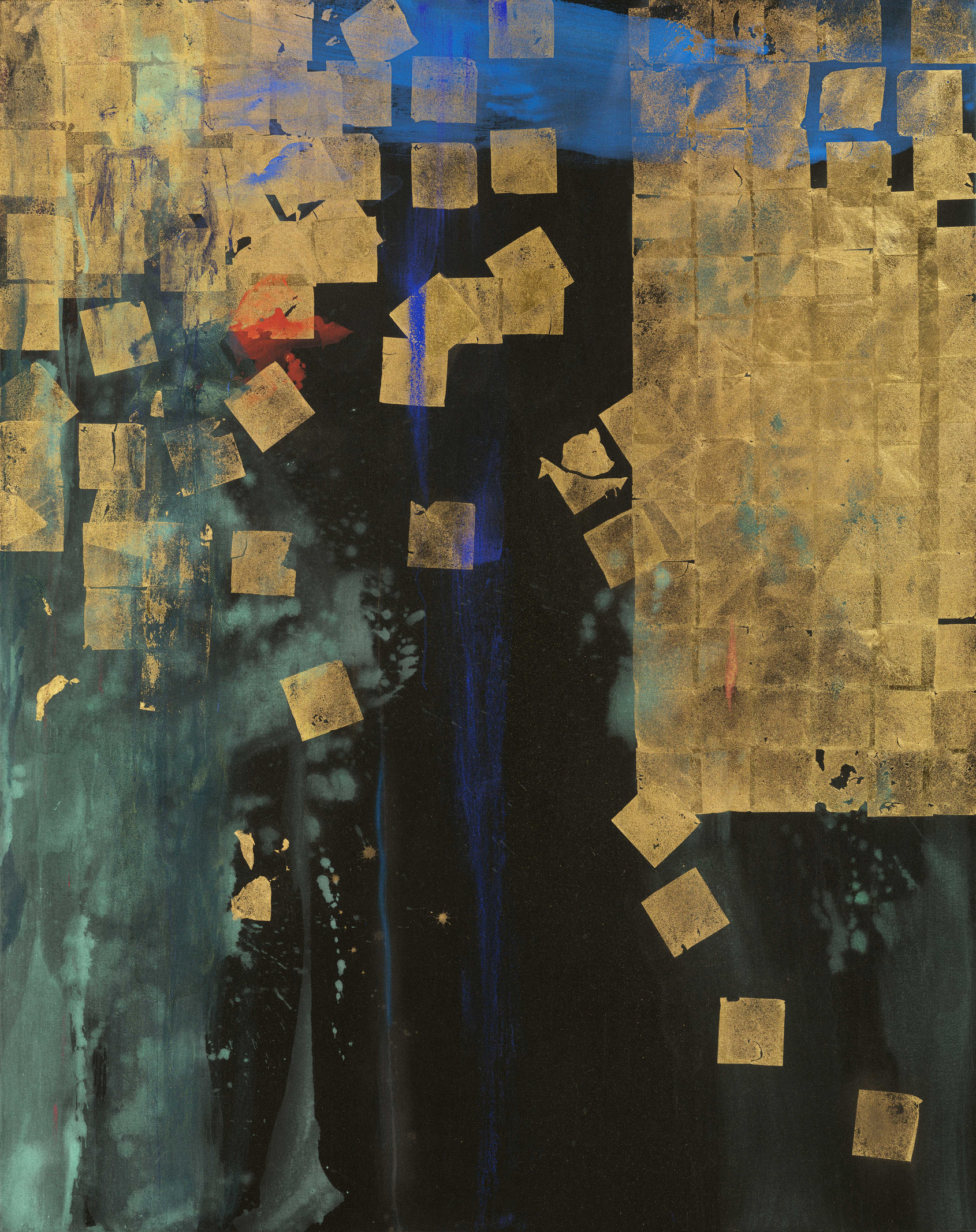 Soliloquies – Joy © Makoto Fujimura The Tears of the Light (2018)
Soliloquies – Joy © Makoto Fujimura The Tears of the Light (2018) In the Bible, there are two passages where Jesus is said to have wept. Once, when he foresaw the destruction that would come upon Jerusalem for rejecting him; and once, when he stood before the house of Lazarus, moved by the sorrow of the dead man’s sisters. “
Jesus wept” — in the King James Version, the shortest and yet one of the most moving sentences.
The British writer C. S. Lewis (1898–1963) once wrote in a poem that the tears of Jesus are the very expression of love. Though sent into the world to heal, to teach, and to suffer out of compassion—a mission that plunged him into an agony as searing as hell itself—humanity would, in the end, behold a world renewed, as fresh as the coming of spring.
“
The Tears of the Light” unfurls with fierce tension, bearing imagery of torn veils, trembling earth, shattered rock, and floodwaters sweeping away. Yet even within this force, there emerges the promise of hope and rebirth.
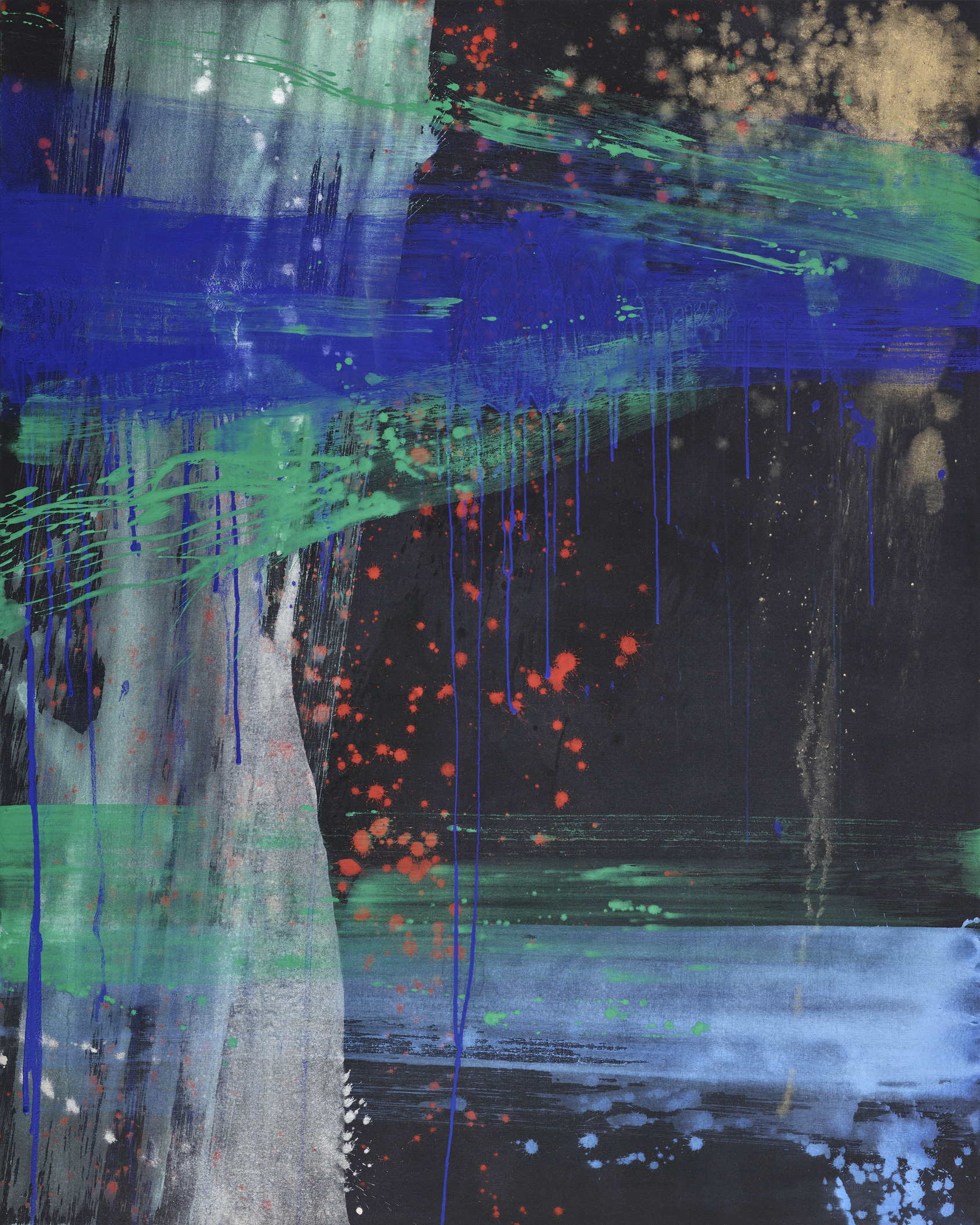 The Tears of the Light © Makoto Fujimura Ki-Seki – Life II (2023)
The Tears of the Light © Makoto Fujimura Ki-Seki – Life II (2023) The Japanese word “Ki-Seki” can mean both “tree rings” and “miracle.” When Makoto Makoto Fujimura moved into a farmhouse in Princeton, he was told that the old pear tree in the yard would likely never bloom again. Yet, to his surprise, it blossomed the very next year. Inspired by this event, the artist created “Ki-Seki”, inviting us to perceive in our daily lives such “small resurrections.”
The main structure of the painting — the tree’s branches — is rendered with the economy of ink lines, while blossoms and traces of rings are layered through mineral pigments, shell-white, and gold and silver leaf, forming luminous circular marks that evoke both the passage of years and the vestiges of light. The space itself rejects linear perspective, unfolding instead as a “breathing space” made of translucent mineral hues, where shifting light catches the metallic fragments, creating a depth that seems to flow.
Encountering “Ki-Seki” thus becomes an experience of time inscribed and grace revealed — an emblem of renewal offered to the beholder.
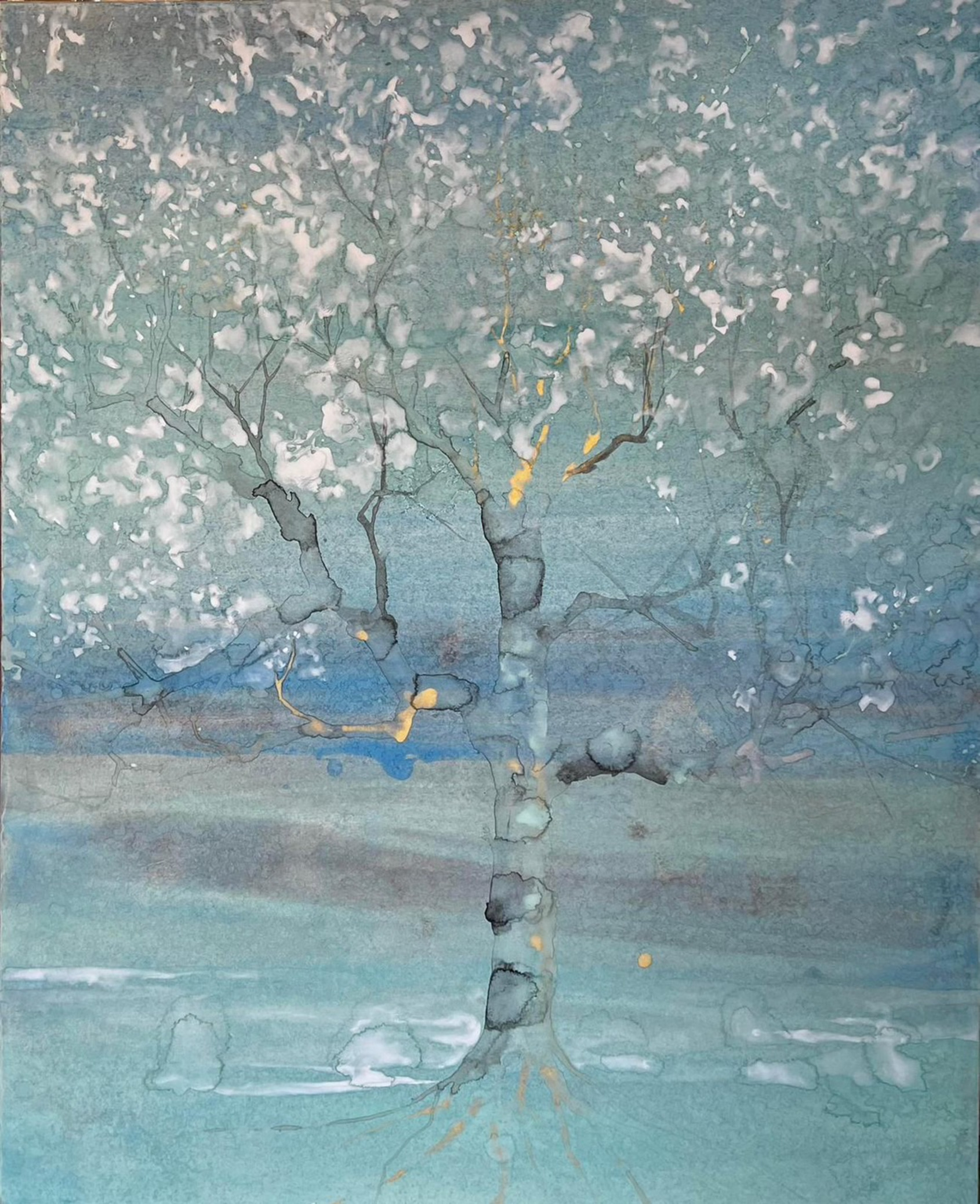 Ki-Seki - Life II © Makoto Fujimura The Silence of Light (2017)
Ki-Seki - Life II © Makoto Fujimura The Silence of Light (2017) “
The Silence of Light” belongs to Makoto Fujimura’s Silence series. The word Silence may be rendered as either “silence” or “stillness.” Deeply inspired by the celebrated Japanese author Shusaku Endo and his novel “Silence”, Makoto Fujimura probes the struggle of the human heart in the face of suffering: silence as the weight of an inner conflict, silence as the mute endurance of the earth, silence as the loneliness borne without words. Yet the crucial question remains—what is heard within that silence? Perhaps divine love does not shatter silence with sound, but rather reveals itself from within it, manifesting as light that unfolds before the beholder.
This theme also serves as an homage to Makoto Fujimura’s father, a scholar of language and acoustics. Through the medium of visual art, the artist seeks to capture the “sound waves” of silence itself, rendering visible a beauty that is hidden yet ever present.
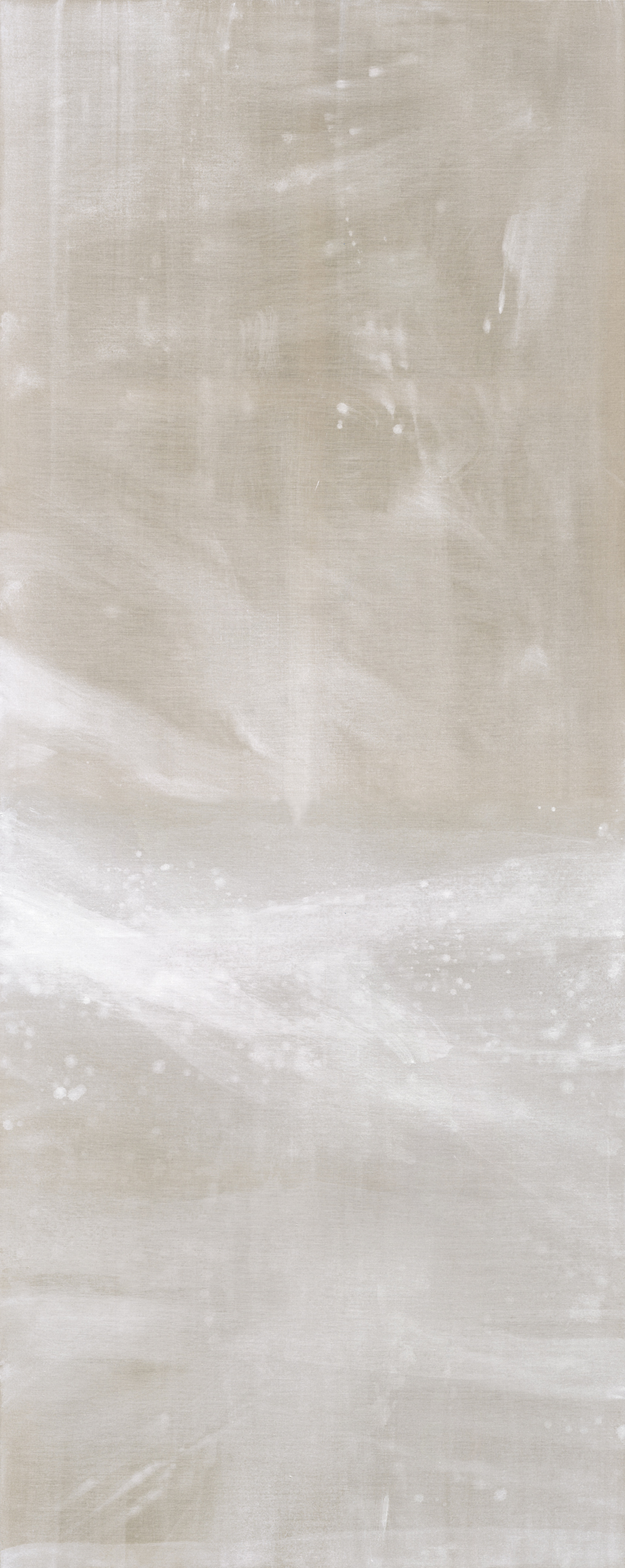 The Silence of Light © Makoto Fujimura The Story of a Bouquet
The Silence of Light © Makoto Fujimura The Story of a BouquetMakoto Fujimura often recalls a story about a bouquet of flowers.
It was shortly after his marriage to Judy. Judy was pursuing her master’s degree, while Makoto Fujimura was teaching at school and painting at home whenever he found time. Their life was financially strained, and canned food was often their staple.
One evening, with no money left and the refrigerator bare, Makoto Fujimura sat in despair, weighed down by rent payments and the expenses of the coming weekend. He waited at home, uncertain and anxious, for Judy to return.
To his surprise, when she arrived, she carried not food but a bouquet of flowers. Angrily, he asked, “We can barely afford to eat—why would you buy flowers?” To which she replied: “Because our souls need to be fed as well.”
These words engraved themselves deeply in his heart. He realized that as an artist, his calling was precisely to nourish the soul—yet in his worry over the future, he had forgotten his true vocation and mission. Since then, her words have remained indelibly within him.
The lily, symbol of purity and faithful love, becomes a recurring motif. Through Makoto Fujimura’s layered technique, mineral pigments, metals, and mother-of-pearl undergo subtle transformations over time. His works are not mere depictions of a single moment; rather, they transcend natural representation to become living forms that breathe with time—reminding us to cherish the beauty of life and the soul.
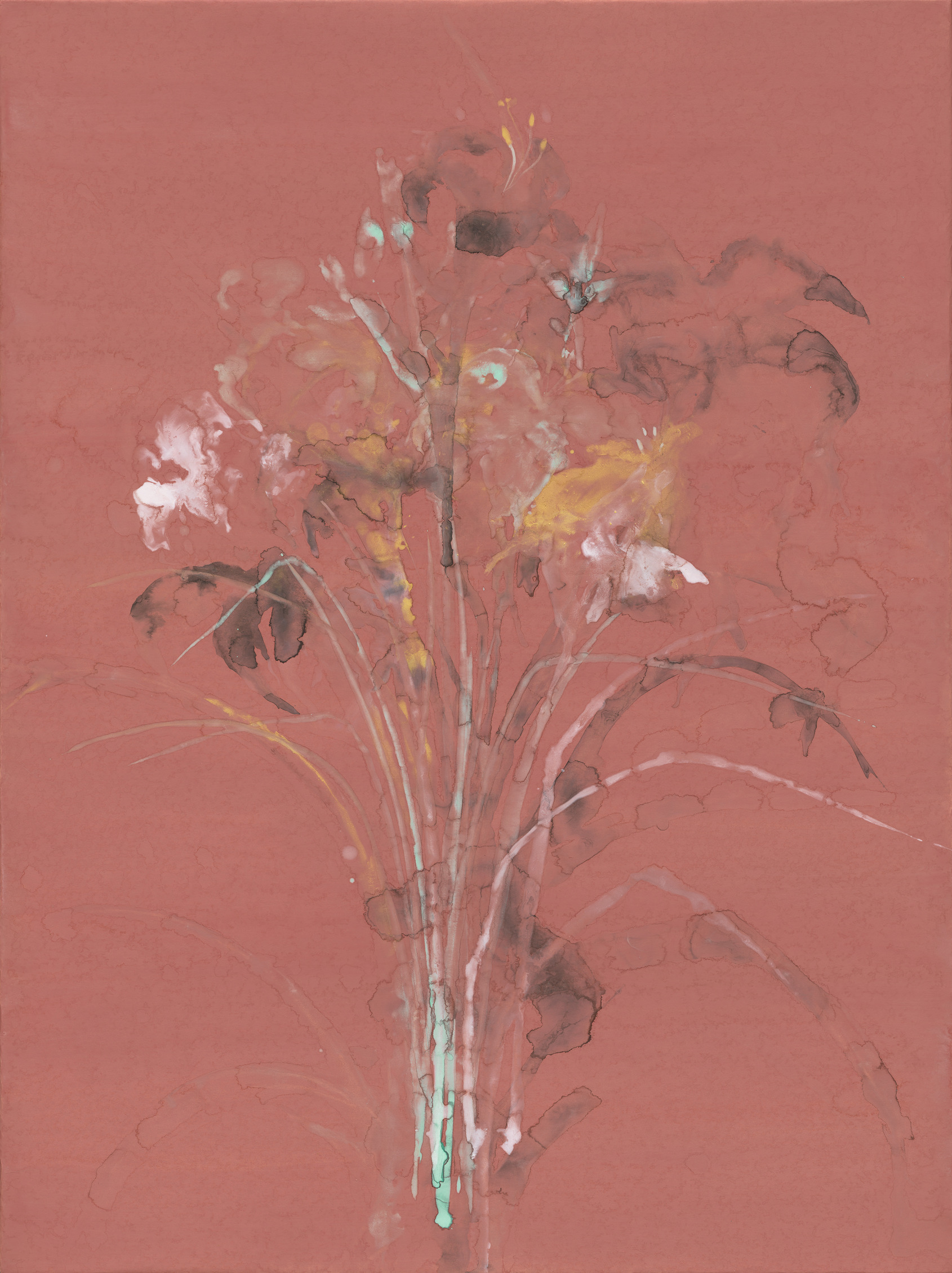 Callis Lilies © Makoto Fujimura
Callis Lilies © Makoto Fujimura
Richard Chang bridges corporate management and the humanities, devoting himself to cultural education. Founder of “Dunnan Art Forum,” he promotes art history, aesthetics, and literature, interpreting complex concepts in accessible language that connects audiences with artists. His combined academic and practical expertise allows him to balance rational analysis with emotional insight. As academic director for Dust and Gold, he provides philosophical and cultural depth, guiding viewers to see how Makoto Fujimura and Shozo Michikawa engage time, matter, and life in their work. Chang serves as both bridge and guide, ensuring that Dust and Gold becomes not only a visual exhibition but also a profound spiritual journey into the essence of art and existence.








